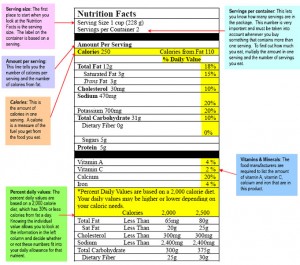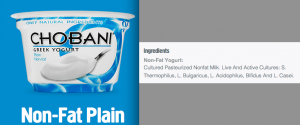
Many people suggest “counting calories” when they want to lose weight but I do not use this method, nor recommend it. I do believe you need to know what a serving size looks like and eat things within moderation BUT if you take up becoming a mathematician for the rest of your life, that is a lot of work and could make you crazy! You want to create habits that are life long. Learning about the quality of foods is much more realistic and life long than counting calories. I don’t know about you but counting calories sounds really monotonous, tedious and NO fun! I suggest you learn to read food labels and understand what quality is over “calories”. Let’s breakdown the nutrition label so you have a better understanding of what you are looking for.
SERVING SIZE: is the first line of the nutrition label and one of the most important things to understand and draw your attention to. A product that is being marketed as a “low calorie snack”, “low fat food”, “low carb food” “trans fat free”, etc. is only talking about one serving. If a serving is the size of a grape and you have “3 grapes”, well you have just had 3 servings. That “low calorie food” or whatever it is stating, can easily become a high calorie food, high fat food, high carb food, etc. The information provided on the label is for a serving size so be aware of what a serving size is!
Don’t be fooled by an item that you think is one serving. You think you are eating healthy and purchase a bag of raw almonds, you eat the whole bag and little did you know that bag was 3.5 servings!! That is 3.5x the calories, fat, carbs, sugars, protein, etc. Many snack-sized items or beverages often have 2.5 – 3.5 servings so don’t be fooled!
Immediately under calories on the nutrition label you’ll find that foods sometimes offer “calories from fat.” Generally, you should try to keep fat in your food at an absolute minimum unless the product contains healthy fats from nuts, grains, seeds or avocado. And before you even go there, let me I assure you, Oreos and Doritos do not.
FAT: Most people know by now that not all fats are created equal! Companies in the US are now required to list trans fat since they have been directly linked to clogged arteries. This is the worse fat for you and one you want to watch out for! In general, make sure you see a zero next to the words “trans fat” on the nutrition label. Keep in mind too that this “Zero” is for a serving size. If you have more than one serving, there can be trace amounts of trans fat. A company can list “O grams Trans Fat”, if the fat/serving is under .5 grams. If it is .4 g/serving, that is considered “ZERO”. Now let’s say you have 5 3 servings, that is 1.2 grams of trans fat. Now that is not Zero is it! (Something to keep in mind) Polyunsaturated fats and Monounsaturated fats are the healthy fats, while saturated fats should be consumed in limited quantities. You sound see a break down of fats.
Total Fat/Saturated Fat/ Trans Fat/Poly Unsaturated & Monounsaturated.
Just because an item is high “total fat” does’t mean it is a product you should avoid. Dig a little bit deeper to see what kind of fats it is high in. The Poly and Mono unsaturated fats are acceptable and healthy fats!

SODIUM: is another one to watch out for! Americans are consuming way too much of this mineral, since it is over-used as a preservative for packaged products. The RDA suggests that healthy individuals under the age of 51 limit sodium intake to 2,300 mg per day. You would be surprised how much sodium are in pre packaged foods! Check out some labels and you will see that most have close to 1,000 mg, while some even surpass 2,000 mg — and that’s just for one meal. If you are staying away from packaged and processed foods, you will find that it is easy to keep your sodium levels in check BUT if you are going for convenience foods, that is when you could be over your limit with just one meal!
CARBOHYDRATES: The next line on the nutrition label lists the grams of carbohydrates. You should NOT be afraid of carbs but you should know how to read them. Not all carbs are created equal! You need to understand how to read the “ingredients” to know if the carbs are coming from a healthy source like oats, grains, wheat, etc. OR if they are coming from white flour, corn starch, sugars, etc. Typically a good carb will have a higher amount of fiber listed. If an item has 27 grams of carbs/serving with 7 grams of Fiber, the total amount of carbs is 27 BUT if you subtract the fiber from that amount, you get the Net Carbs which comes out to 20g/serving. The higher the fiber the less the Net Carbs. This helps not only reach your fiber intake for the day but fibrous carbs help slow down the digestion of Carbs and therefore do not spike your blood sugar as rapidly as “bad carbs” such as white bread, sugar, processed foods, chips, etc. Most Americans do not consume enough fiber, which can lead to problems like constipation and even weight gain. It is suggested that for optimal digestive health, adults should aim for at least 35 grams of fiber per day. Sugar, of course, should be kept at a minimum.
PROTEIN: The recommended daily intake for protein ranges from 40 to 60 grams per day depending on a person’s weight, gender and age. Now this is completely bogus if you are an athlete or working out. A better rule of thumb is .85- 1gram of protein per pound of body weight. If you are aggressively following a workout program, this number can even increase to 1.5-1.75 grams/pound. Most dietary protein comes from animal proteins such as dairy, meat, fish, and eggs. You can also get your protein from other sources such as vegetables, seeds, beans and nuts. Due to the range of protein requirements among individuals, you will have to base your daily intake on your personal needs and lifestyle.
The percent daily value (the column on the right) calculates the percentage of your daily value that an item/serving contains based on a 2,000 calorie diet, but if anything this number just confuses people since not everyone follows a 2,000 calorie diet!
INGREDIENTS: The best way to make an even more educated decisions about what you are eating, it is important to pay attention to the list of ingredients. A good rule of thumb is the shorter the list the better. If the list is a paragraph long, you know that there are tons of additions to a product. The more wholesome and natural a product, the lest ingredients will be listed. You also want to look for names that you cannot pronounce, those are typically chemicals that have been added to a product to enhance the shelf life. Look for names of ingredients that you have heard of, or at the very least, you can pronounce. Ingredients are listed in descending order by what is most prevalent in the product. Look for products that have whole grains, vegetables and fruits at the top of that list, and sugar and additives should appear closer to the bottom.
SUMMERY: Make sure to watch your servings, types of fats and carbohydrates, and always, always, read the ingredients listed! Stick to whole, natural foods over overly processed junk food.
This is an example of 2 Greek Yogurts– One “100 Calorie” and the other slightly higher calorie (120 calories) but check out the Ingredients!
 vs
vs

The 100 calorie serving has added sugar, corn starch, natural flavor, sucralose and other additional ingredients.
The other Chobani non fat Greek Yogurt version has only non fat milk and active cultures! Without the fruit it actually has 100 calories/ 6 ounces. You then can add your own fruit and now you have a super healthy ALL natural option.
CALORIES AREN’T EVERYTHING! Learn to read labels and choose quality over “low calories”.

